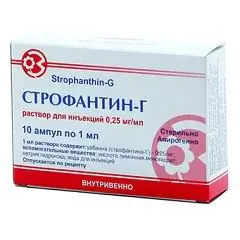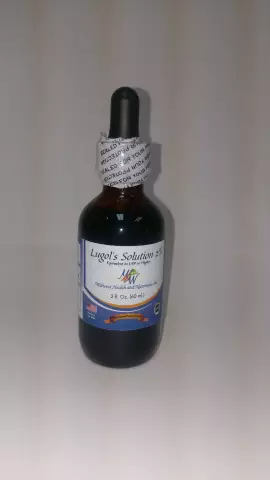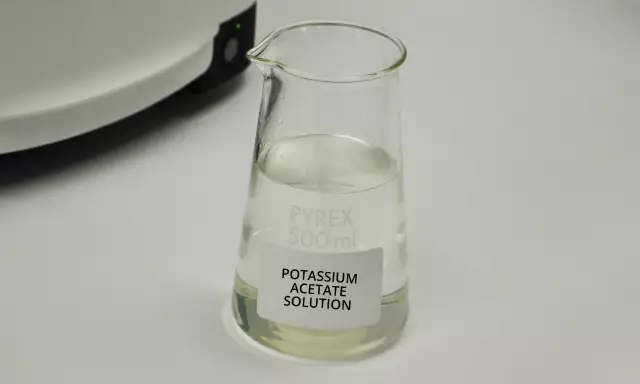- Author Rachel Wainwright [email protected].
- Public 2023-12-15 07:39.
- Last modified 2025-11-02 20:14.
Strofantin-G
Strofantin-G: instructions for use and reviews
- 1. Release form and composition
- 2. Pharmacological properties
- 3. Indications for use
- 4. Contraindications
- 5. Method of application and dosage
- 6. Side effects
- 7. Overdose
- 8. Special instructions
- 9. Application during pregnancy and lactation
- 10. In case of impaired renal function
- 11. For violations of liver function
- 12. Use in the elderly
- 13. Drug interactions
- 14. Analogs
- 15. Terms and conditions of storage
- 16. Terms of dispensing from pharmacies
- 17. Reviews
- 18. Price in pharmacies
Latin name: Strophanthin-G
ATX code: C01AC01
Active ingredient: uabain (Uabain)
Manufacturer: LLC Experimental Plant of the State Scientific Center of Medicines (Ukraine); LLC "Pharmaceutical company" Health "(Ukraine)
Description and photo update: 2020-15-01

Strofantin-G is a cardiotonic drug with an antiarrhythmic effect.
Release form and composition
The drug is available in the form of a solution for intravenous (iv) administration: clear liquid without color [1 ml in ampoules (including with a ring or break point): 10 ampoules in a cardboard box complete with a ceramic cutting disc or ampoule scarifier (or without them); 5 ampoules in a blister strip, in a cardboard box 1 or 2 packages complete with a ceramic cutting disc or ampoule scarifier (or without them); 10 ampoules in a blister strip, in a cardboard box 1 pack complete with a ceramic cutting disc or ampoule scarifier (or without them). Each pack also contains instructions for the use of Strofantin-G].
1 ml of solution contains:
- active substance: ouabain - 0.25 mg;
- auxiliary components: sodium hydroxide, citric acid monohydrate, water for injection.
Pharmacological properties
Pharmacodynamics
Strofantin-G is a cardiotonic drug that has an antiarrhythmic effect. Its active ingredient, ouabain, is a cardiac glycoside that blocks sodium-potassium adenosine triphosphatase of the cell membrane of cardiomyocytes. The drug helps to increase the strength and speed of heart contractions (positive inotropic effect), decrease AV (atrioventricular) conduction (negative dromotropic effect). In subtoxic and toxic doses, ouabain stimulates a decrease in heart rate (HR), exhibiting a negative chronotropic effect, and, due to a decrease in the excitability threshold, potentiates the formation of heterotopic impulses.
In case of heart failure, the use of Strofantin-G provides an increase in the stroke and minute blood volume, a decrease in the end-diastolic volume of the ventricles and the size of the heart, and a decrease in myocardial oxygen demand.
After intravenous injection, clinical improvement is observed within 2-10 minutes, the maximum therapeutic effect is achieved in 30-120 minutes and lasts 1-3 days.
Pharmacokinetics
Plasma protein binding - 40%.
In the body, ouabain is not metabolized.
It is excreted unchanged through the kidneys.
Indications for use
- decompensated chronic heart failure;
- acute heart failure;
- flutter and atrial fibrillation;
- supraventricular tachycardia.
Contraindications
Absolute:
- AV block II degree;
- glycosidic intoxication;
- Wolff-Parkinson-White syndrome;
- intermittent complete blockade;
- hypersensitivity to the components of the drug.
Care should be taken to prescribe a solution of Strofantin-G to patients with acute myocardial infarction, atrial extrasystole, AV block of the 1st degree, a history of Morgagni-Adams-Stokes attacks, sick sinus syndrome without an artificial pacemaker, hypertrophic subaortic stenosis, cardiac stenosis in (in the absence of a tachysystolic form of atrial fibrillation), isolated mitral stenosis with low heart rate, unstable angina pectoris, arteriovenous shunt, myocarditis, heart failure with impaired diastolic function (heart amyloidosis, restrictive cardiomyopathy, constrictive pericarditis, cardiac dilatation) or cardiac tamponade cavities of the heart, prerequisites for unstable conduction of excitation along the atrioventricular node, cor pulmonale,hypercalcemia, hypernatremia, hypokalemia, hypomagnesemia, with renal and / or hepatic insufficiency, hypothyroidism, thyrotoxicosis, alkalosis, obesity, in old age.
During pregnancy and breastfeeding, the use of Strofantin-G is allowed only under the strict supervision of a physician in cases where the intended benefits of therapy for the mother outweigh the potential risk for the fetus and child.
Strofantin-G, instructions for use: method and dosage
Strofantin-G solution is used by slow intravenous injection.
The dose should be selected individually, taking into account the nosology and patient's response to therapy.
Recommended dosage at an average rate of digitalization: saturation period - 0.25 mg (1 ml) at intervals of 12 hours for 48 hours. If clinically necessary, you can additionally enter 0.1-0.15 mg at intervals of 0.5-2 hours …
The maximum daily dose of Strofantin-G is 1 mg (4 ml), the maintenance daily dose is 0.25 mg.
Side effects
Adverse reactions arising from the use of Strofantin-G [are classified as follows: very often (> 1/10); often (> 1/100 and 1/1000 and 1/10 000 and <1/1000); extremely rare (<1/10 000, including individual messages)]:
- from the cardiovascular system: infrequently - a feeling of compression behind the sternum, palpitations, shortness of breath, tachycardia, bradycardia, arrhythmias;
- from the central nervous system: often - fatigue, dizziness, headache; extremely rare - anxiety;
- from the digestive system: often - nausea; infrequently - vomiting;
- on the part of the skin: infrequently - increased sweating;
- from the reproductive system: rarely - priapism;
- from the urinary system: often - proteinuria; rarely - nephrotic syndrome, nephropathy;
- allergic reactions: rarely - skin redness, pruritus, exanthema;
- laboratory parameters: extremely rare - thrombocytopenia.
Overdose
Symptoms: the earliest signs of glycosidic intoxication include the appearance of cardiac arrhythmias (ventricular paroxysmal tachycardia, ventricular premature beats, including polytopic ventricular premature beats, bigeminy, nodal tachycardia, sinoatrial blockade, flutter and fibrillation), AV-blockade and fibrillation. When the condition aggravates, the patient develops abdominal pain, diarrhea, intestinal necrosis, on the part of the organ of vision - flashing of "flies" in front of the eyes, decreased visual acuity, perception of visible objects in yellow-green color and reduced or enlarged form; development of manic-depressive syndrome, the appearance of paresthesias, neuritis, radiculitis.
Treatment: the introduction of an antidote - sodium dimercaptopropanesulfonate, sodium calcium edetate; the appointment of symptomatic therapy. As antiarrhythmic drugs, the use of class I drugs (phenytoin, lidocaine) is indicated, with severe bradycardia, AV blockade - m-anticholinergic blockers. In hypokalemia, a solution of potassium chloride is injected intravenously in combination with a 5% dextrose solution and short-acting insulin, the duration of the infusion is 3 hours. With a complete transverse blockade with attacks of Morgagni-Adams-Stokes, temporary pacing is required. Beta-adrenomimetics should not be administered due to the increased risk of increased proarrhythmogenic action of cardiac glycosides. Taking into account the patient's condition, the use of Strofantin-G should be canceled or reduced in the next dose and the interval between procedures should be increased.
special instructions
Taking into account the narrow therapeutic range of Strofantin-G, patients need an individual dose selection and careful medical supervision during the period of its use.
It should be borne in mind that with hypercalcemia, hypernatremia, hypokalemia, hypomagnesemia, severe dilatation of the heart cavities, cor pulmonale, alkalosis and in elderly patients, the likelihood of overdose is increased.
Treatment of patients with AV conduction disturbances is recommended to be accompanied by ECG monitoring (electrocardiogram) and to take special care.
Influence on the ability to drive vehicles and complex mechanisms
During the treatment period, one should refrain from driving vehicles and engaging in other potentially hazardous activities, the implementation of which requires the speed of psychomotor reactions and increased concentration of attention.
Application during pregnancy and lactation
With caution and under the supervision of a physician, it is allowed to use Strofantin-G during pregnancy and breastfeeding, after a thorough assessment of the ratio of the expected benefits of therapy for the mother and the potential threat to the fetus and child.
With impaired renal function
It is recommended to use Strofantin-G with caution for the treatment of patients with renal insufficiency.
In order to prevent glycoside intoxication in patients with impaired renal excretory function, it is recommended to reduce the usual dose.
For violations of liver function
It is recommended to use Strofantin-G with caution for the treatment of patients with hepatic insufficiency.
Use in the elderly
Care should be taken to prescribe Strofantin-G for the treatment of elderly patients. It is important to carefully select the required dose due to the increased risk of overdose.
Drug interactions
- adrenomimetics, methylxanthines, tricyclic antidepressants, reserpine: the combination with each of these agents increases the risk of heart rhythm disturbances;
- verapamil, magnesium sulfate, beta-blockers, class IA antiarrhythmics: help to increase the severity of lowering AV conduction;
- methyldopa, quinidine, clonidine, verapamil, spironolactone, amiodarone, captopril, tetracycline, erythromycin: against the background of concomitant therapy with one of the above drugs, the concentration of ouabain in the blood increases, due to a competitive decrease in its secretion by the proximal tubules of the kidneys;
- glucocorticosteroids (GCS), diuretics: the likelihood of hypomagnesemia and hypokalemia increases;
- angiotensin-converting enzyme blockers, angiotensin II receptor antagonists: the interaction of ouabain with drugs in this group helps to reduce the risk of hypomagnesemia and hypokalemia;
- insulin, calcium salts, diuretics (especially thiazide diuretics and carbonic anhydrase inhibitors), corticosteroids, catecholamines: the risk of glycosidic intoxication increases.
Analogs
The analogues of Strofantin-G are Strofantin K, Strofantin-Darnitsa, Digoxin, Hawthorn, Aurocard, Doppelgerts Cardiovital, Korglikon, Krategus, Novodigal, Dobutamine, Dopamine, Ubidekarenon, etc.
Terms and conditions of storage
Keep out of the reach of children.
Store at temperatures from 15 to 25 ° C, protected from light.
The shelf life is 3 years.
Terms of dispensing from pharmacies
Dispensed by prescription.
Reviews about Strofantin-G
Reviews of Strofantin-G, left by patients or doctors, are currently absent.
Price for Strofantin-G in pharmacies
The price of Strofantin-G for a package containing 10 ampoules can range from 70 rubles.

Maria Kulkes Medical journalist About the author
Education: First Moscow State Medical University named after I. M. Sechenov, specialty "General Medicine".
Information about the drug is generalized, provided for informational purposes only and does not replace the official instructions. Self-medication is hazardous to health!






